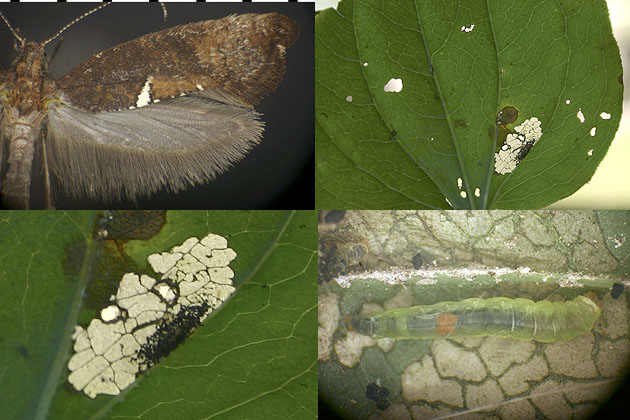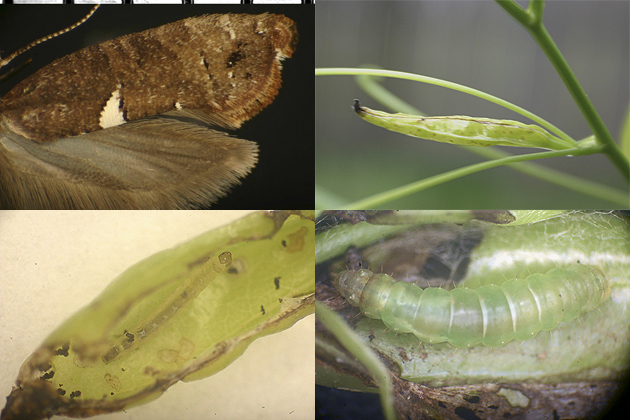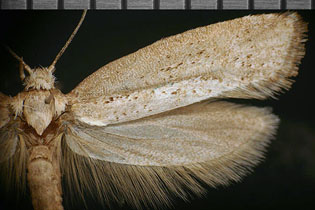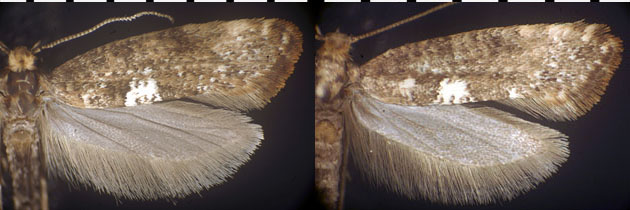
Figure 1. Meshwork cocoon, typical of Acrolepiidae. Left, Acrolepiopsis incertella; right, A. heppneri.
Acrolepiidae is a small group, with only a few species in North America; the New World species were revised by Gaedike (1983), and an excellent review of Nearctic Acrolepiopsis was published by Landry (2007). Acrolepiidae might properly be considered a subfamily within Plutellidae, with which it is closely allied. Larvae of Midwestern acrolepiid species for which life histories are known feed on leaves of greenbriar, especially bristly greenbriar, Smilax tamnoides (Smilacaceae). These species pupate in a characteristic meshwork cocoon (Fig. 1), as is typical for the family. Superficially-similar cocoons occur here and there in other groups of microepidoptera as well (e.g., Schreckensteinia, covered on this site under Heliodinidae). Most of those occurrences are via obviously non-homologous derivation, but see coverage of the genus Prays, under the family Yponomeutidae. So far as is known, three univoltine species, all in the genus Acrolepiopsis, occur in Illinois.

Figure 1. Meshwork cocoon, typical of Acrolepiidae. Left, Acrolepiopsis incertella; right, A. heppneri.
Until it was found in central Illinois in late 2006, Acrolepiopsis heppneri (Fig. 2) was known only from New Hampshire, Connecticut, and North Carolina. It feeds as a larva in late September and early October (central Illinois) on bristly greenbriar, in low-lying deciduous forest. It constructs and lives inside a black, frass-covered silken tube that abuts a leaf vein on the underside of the leaf, and it feeds by skeletonizing the leaf blade in the area surrounding the silken tube. The adult emerges in October and remains reproductively inactive until the following September. A slug sawfly larva and a tiger moth larva both skeletonize Smilax leaves at the same time as does A. heppneri, but the damage of those insects can be readily differentiated from that of A. heppneri by the fact that it lacks the black larval tube.

Figure 2. Acrolepiopsis heppneri. Top: left, adult; right, overview of leaf damage on bristly greenbriar, Smilax tamnoides (Smilacaceae); bottom: left, closeup of larval damage; right, mature larva. The paired orange discs in the abdomen of the larva shown here indicate that it is male.
Acrolepiopsis incertella (Fig. 3) feeds on bristly greenbriar, as does A. heppneri, but unlike A. heppneri, the larva of A. incertella occurs in spring (early May in central Illinois), and it feeds only upon the new terminal leaf of the plant. The leaf is tied together into a long tapering formation inside which the larva feeds and develops. Because of its waxy surface and yellowish-green color, the tied leaf somewhat resembles a small-scale version of a hot pepper. Soon after the larva begins feeding, the apex of the leaf becomes necrotic and black; and in the terminal stages of larval feeding, skeletonization is sometimes seen externally on the rolled leaf. After feeding, the larva leaves the tied leaf, spins its cocoon, pupates, and emerges in late May to early June as an overwintering adult. The adult is very similar in external appearance to that of A. heppneri, but these two species differ markedly on male and female genital morphology (see illustrations in Gaedike 1983 and Landry 2007).

Figure 3. Acrolepiopsis incertella. Top: left, adult; right, leaf damage on bristly greenbriar, Smilax tamnoides (Smilacaceae); bottom: left, young larva; right, mature larva.
Acrolepiopsis leucoscia (Fig. 4) is known only from the adult stage. It is seldom collected, with only a handful of specimens being known, these from scattered localities in Ohio, Illinois, and Texas (the majority of records being from the latter state). In central Illinois, it has been collected from deciduous forest in two localities. It is much larger than either A. incertella or A. heppneri and is colored quite differently. The moth has been collected in late April and early May. At that time, the vestiture is in good condition, which suggests that A. leucoscia winters in either the larval or pupal stage and emerges in spring.

Figure 4. Acrolepiopsis leucoscia. Adult, collected at light.
Acrolepiopsis assectella (Fig. 5) is generally similar in adult pattern and coloration to A. heppneri and A. incertella, but the forewing is on average slightly paler and more mottled, with the whitish patch on the hind margin larger and more diffuse, than in those two species. Also, it almost completely lacks the sharp indentation in the outer margin of the forewing, just below the apex, and the accompanying small white patch in the fringe, that are seen in A. heppneri and A. incertella.This insect is known as the leek moth. It is native to the Old World but recently has been detected in North America (southeastern Canada). The larva feeds on various plant species in the genus Allium (Liliaceae), including some species that are cultivated for human food (e.g., onion, chives, garlic, and Shallot). The preferred larval host is leek (Allium porrum), and the larva of A. assectella is considered a serious pest of this plant in Europe (an aggravating factor undoubtedly being that, unlike the Nearctic Acrolepiopsis species, A. assectella is multivoltine). Leek moth should be watched for in North America (especially in northern regions), to determine whether it will expand its range now that it is present here.
The moth receives extensive coverage in Landry (2007), cited above. Also, the Canadian Food Inspection Agency (with Dr. Landry as a major contributor) has produced an excellent Fact Sheet on the leek moth, with images of larval damage and all life stages of the insect (to view this Fact Sheet, click here); NOTE: the URL for this sheet keeps changing. To view the fact sheet if clicking the "here" link takes you to an error message: starting at the page that you are taken to, click "A-Z index"; then, on the next page, click "Plants" (in the "A-Z index" box), and on the next page, scroll down the alphabetical list until you reach, under P, the subject heading "Plant Pests--common name" and scroll down the alphabetical list under that subject heading, until you get to "Leek Moth"; click on that, to bring up the fact sheet.

Figure 5. Leek moth, Acrolepiopsis assectella. Adults; specimens provided coutesy of Dr. Jean-François Landry.